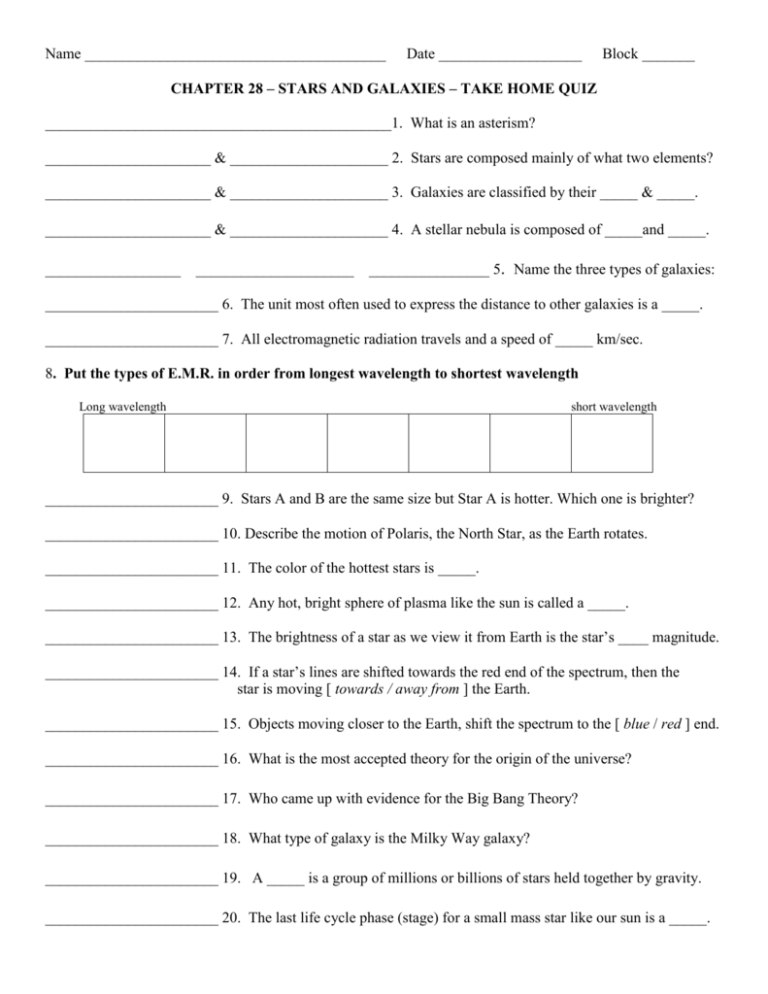Quiz #4 * The Electromagnetic Spectrum and Stars
advertisement

Name ________________________________________ Date ___________________ Block _______ CHAPTER 28 – STARS AND GALAXIES – TAKE HOME QUIZ ______________________________________________1. What is an asterism? ______________________ & _____________________ 2. Stars are composed mainly of what two elements? ______________________ & _____________________ 3. Galaxies are classified by their _____ & _____. ______________________ & _____________________ 4. A stellar nebula is composed of _____and _____. __________________ _____________________ ________________ 5. Name the three types of galaxies: _______________________ 6. The unit most often used to express the distance to other galaxies is a _____. _______________________ 7. All electromagnetic radiation travels and a speed of _____ km/sec. 8. Put the types of E.M.R. in order from longest wavelength to shortest wavelength Long wavelength short wavelength _______________________ 9. Stars A and B are the same size but Star A is hotter. Which one is brighter? _______________________ 10. Describe the motion of Polaris, the North Star, as the Earth rotates. _______________________ 11. The color of the hottest stars is _____. _______________________ 12. Any hot, bright sphere of plasma like the sun is called a _____. _______________________ 13. The brightness of a star as we view it from Earth is the star’s ____ magnitude. _______________________ 14. If a star’s lines are shifted towards the red end of the spectrum, then the star is moving [ towards / away from ] the Earth. _______________________ 15. Objects moving closer to the Earth, shift the spectrum to the [ blue / red ] end. _______________________ 16. What is the most accepted theory for the origin of the universe? _______________________ 17. Who came up with evidence for the Big Bang Theory? _______________________ 18. What type of galaxy is the Milky Way galaxy? _______________________ 19. A _____ is a group of millions or billions of stars held together by gravity. _______________________ 20. The last life cycle phase (stage) for a small mass star like our sun is a _____. _______________________ 21. The element _____ is the “fuel” of the sun. (What kind of fusion?) _______________________ 22. By using a tool called a _____ astronomers can identify the elements in a star. _______________________ 23. On an H-R Diagram, stars are classified by _____ and _____. _______________________ 24. What is the next stage in the life cycle of the sun? _______________________ 25. An example of a winter constellation is _____. _______________________ 26. Stars that are hot, dim, and small are called _____. _______________________ 27. A _____ is the densest object in the universe, and no light escapes. _______________________ 28. _____ magnitude is a measurement that compares the true brightness of stars. _______________________ 29. What kind of spectrum comes from white light? _______________________ 30. Some constellations can only be seen during certain seasons because _______________________ 31. The part of the electromagnetic spectrum that can be separated into colors of the rainbow is called _____. _______________________ 32. The _____ of a star will determine the evolutionary course a star will take. _______________________ 33. The sun is a _____ star. (what type?) _______________________ 34. The explosion of a massive star at the end of its life is called a _____. _______________________ 35. The constellation that contains the “pointer stars” used to find Polaris is ____. _______________________ 36. The first stage in the life cycle of a star is called a _____. _______________________ 37. Which type of galaxy has all its stars concentrated in the middle? _______________________ 38. Which type of galaxy is typically the faintest? _______________________ 39. What does a light year measure? _______________________ 40. Which star will appear brighter in the night sky, a star with an apparent magnitude of 0 or a star with an apparent magnitude of +1? _______________________ 41. Observing red shifts, most astronomers agree that the universe is _____. _______________________ 42. The further away a galaxy is from us the [ faster / slower ] it is moving. Use the HR diagram to answer the following questions: 43. Name the two brightest stars labeled. ______________________________________ 44. Which star is hotter, Vega or Capella? ______________________________________ 45. Which group of stars is the dimmest? ______________________________________ 46. What group of stars does Arcturus belong to? ______________________________________ 47. In the diagram below, circle the letter in the position where we would find our solar system. ______________________ 48. What type of galaxy is shown in the picture? 49-50. Label the constellations & the North Star in the diagram below.









